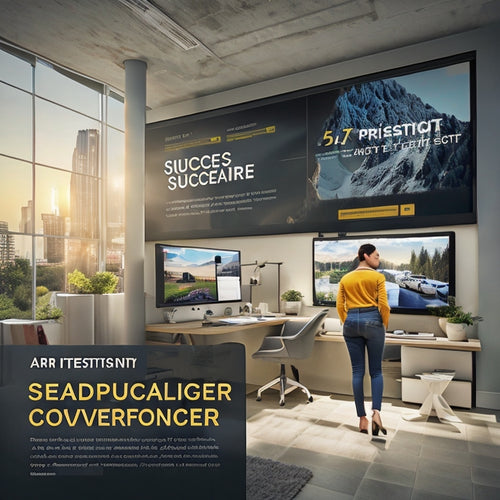
Ultimate Guide to Top-Notch Ecommerce Websites
Share
You're on the path to creating an ecommerce website that drives conversions and leaves a lasting impression on customers. To get there, you'll need to craft a visually stunning homepage that optimizes for engagement, builds consumer trust through trust indicators and customer reviews, and elevates the product experience with interactive features and visual storytelling. But that's not all - you'll also need to guarantee a seamless cart and checkout process, implement responsive design, and prioritize clear navigation and search functionality. By mastering these strategies, you'll be well on your way to creating a high-quality ecommerce website that sets you apart from the competition and drives real results.
Key Takeaways
• Craft a visually stunning homepage that optimizes for engagement with compelling calls to action and emotional photography.
• Build consumer trust by highlighting trust indicators, showcasing customer reviews, and ensuring secure transactions.
• Elevate product experiences with customization options, interactive features, and immersive storytelling to drive conversions.
• Guarantee a seamless cart and checkout process with minimal friction, upfront fees, and multiple payment options.
• Implement responsive design and prioritize clear navigation, search functionality, and streamlined checkout to maximize conversions.
Designing for Engagement
To craft an ecommerce website that truly resonates with your target audience, you must prioritize designing a homepage that's both visually stunning and strategically optimized to drive engagement, with compelling calls to action and emotional photography that speaks directly to their needs and desires.
By incorporating interactive features, you'll create a user experience that's immersive and memorable. Visual storytelling is key to forging an emotional connection with your audience, so use high-quality images that evoke feelings and showcase your brand's personality.
Building Consumer Trust
One important facet of ecommerce success is building trust with your customers, and this starts with a website that radiates credibility and transparency. You can achieve this by highlighting trust indicators like customer reviews, ratings, and testimonials. These social proofs will help potential customers feel more confident in their buying decisions.
Moreover, make certain that your website has secure transactions by showcasing security badges and trust marks, such as SSL certificates or VeriSign seals. This will reassure customers that their personal and payment information is secure.
Additionally, establish brand authenticity by clearly presenting your business's physical address, contact information, and policies. By doing so, you'll create a reliable online environment that encourages customers to make repeat purchases and become loyal advocates for your brand.
Elevating Product Experience
By presenting your products in a compelling and informative way, you can captivate customers' attention, drive engagement, and ultimately boost sales.
To elevate the product experience, consider the following strategies:
-
Offer product customization options to let customers personalize their purchases
-
Incorporate interactive features, such as 360-degree views or virtual try-ons, to create immersive experiences
-
Use visual storytelling to showcase products in a lifestyle setting, making it easier for customers to imagine themselves using the product
-
Create immersive experiences through high-quality product videos or demos
-
Provide detailed product information, including specifications, materials, and dimensions, to build trust and confidence in your products
Optimizing Cart and Checkout
As you've carefully curated your product experience, the next essential step is to guarantee a seamless cart and checkout process that minimizes friction and maximizes conversions. You want to make sure that your customers feel secure and confident throughout the process.
To achieve this, show all fees upfront and provide easy cart item updates. Remove navigation on the checkout page and break the order process into clear steps. Offer multiple payment options and display security badges, such as SSL certificates, to reassure customers of your payment security. This will greatly improve your conversion rate.
Best Practices for Success
To secure your eCommerce website converts visitors into loyal customers, you must follow a set of best practices that prioritize user experience, security, and conversions. By doing so, you'll increase conversion optimization and customer retention.
Here are some essential strategies to get you started:
-
Implement a responsive design to guarantee a seamless user experience across all devices
-
Prioritize clear navigation, search functionality, and easy access to customer support
-
Optimize product pages with high-quality images, detailed descriptions, and customer reviews
-
Streamline the checkout process with transparent shipping options and multiple payment methods
-
Continuously monitor and analyze your website's performance to identify areas for improvement
Frequently Asked Questions
How Often Should I Update My Ecommerce Website's Design and Layout?
You should refresh your ecommerce website's design and layout every 2-3 years to guarantee user experience updates, incorporating A/B testing strategies to optimize layout evolution and stay ahead of the competition.
What Is the Ideal Ratio of Product Images to Product Information?
You'll want to strike a balance between product images and information, aiming for a 60:40 ratio, where high-quality visuals drive visual appeal and user experience, while concise content provides necessary details, ensuring a seamless and safe shopping experience.
Can I Use a Single-Page Checkout for All Types of Orders?
You've seen how ASOS's multi-step checkout process allows customers to review orders before payment, ensuring accuracy. For a seamless experience, consider a single-page checkout for simple orders, but offer a multi-step option for customers who prefer a more detailed review.
How Do I Balance Personalization With Customer Data Privacy Concerns?
You balance personalization with customer data privacy concerns by implementing robust data protection measures, ensuring customization doesn't compromise user experience, and being transparent about data collection and usage to build trust with your customers.
What Are the Most Effective Ways to Measure Ecommerce Website Success?
You'll know your ecommerce website is thriving when you track key metrics like conversion rate, customer retention, and user experience, which ultimately drive revenue growth, ensuring a safe and successful online business that resonates with customers.
Related Posts
-

Shopify: The Ultimate E-commerce Solution
Shopify, an e-commerce platform, offers numerous advantages for businesses seeking to establish an online presence. ...
-

Boost Ad Performance and ROI With the Advertiser Success Center
The Advertiser Success Center is a comprehensive platform that offers valuable insights and tools to assist advertis...

